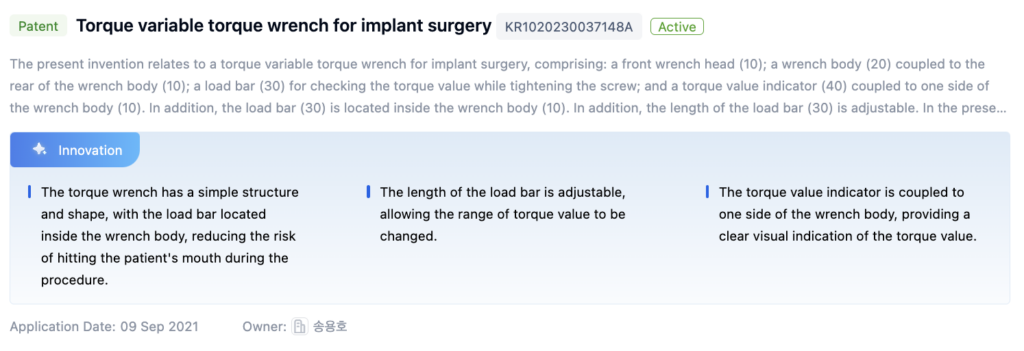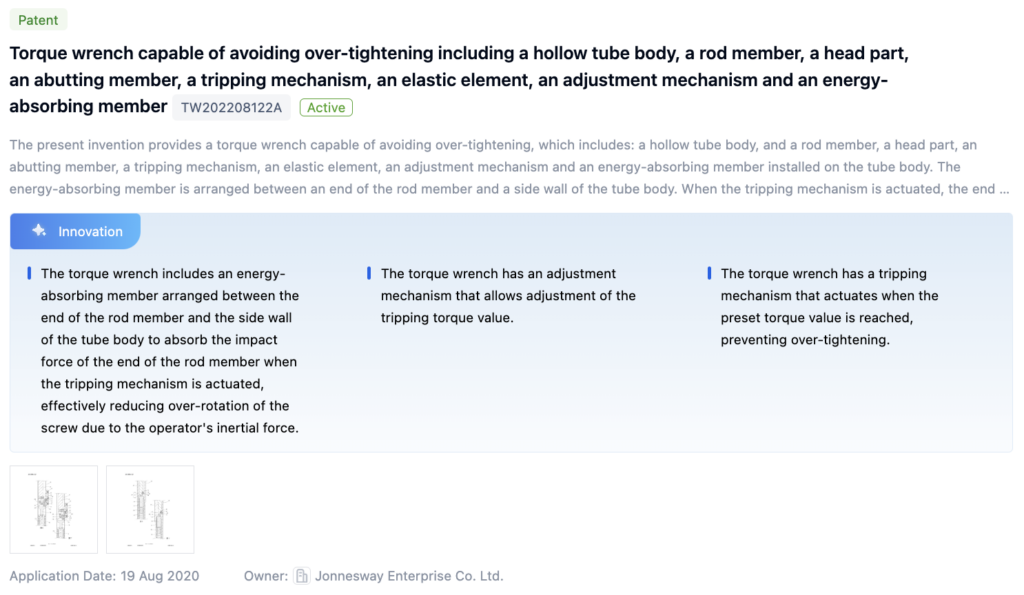
Technical Background and Objectives
Torque wrenches are essential tools in industries like automotive, aerospace, and construction, used to ensure proper tightening of fasteners to specified torque values. Reducing the weight of these tools is increasingly important for improving ergonomics, reducing operator fatigue, and enhancing overall efficiency. Historically, torque wrenches have evolved from mechanical devices relying on springs or levers to more compact and lightweight designs. However, as the demand for higher torque capacities and accuracy grew, so did the weight of these tools. This research aims to explore innovative solutions to significantly reduce the weight of torque wrenches while maintaining or enhancing their performance, durability, and ease of use. This aligns with the industry’s pursuit of ergonomic and efficient tools to improve productivity and worker safety.

To get detailed scientific explanations of the lightweight torque wrenches, try Patsnap Eureka TechResearch.
Market Demand Analysis
The demand for lightweight torque wrenches is growing across various industries:
- Automotive Industry: The need for efficient and ergonomic tools has increased due to the emphasis on worker safety and productivity. Lightweight torque wrenches reduce fatigue and strain on technicians, leading to improved performance and reduced injury risk.
- Aerospace Industry: Weight reduction is critical in aircraft manufacturing, where every pound saved can lead to substantial fuel savings and operational efficiency. Lightweight torque wrenches contribute to overall weight reduction efforts in assembly and maintenance.
- Construction and Manufacturing: These sectors benefit from the improved portability and maneuverability of lightweight torque wrenches, reducing the risk of musculoskeletal disorders and increasing productivity.
- Electronics and Medical Devices: The trend towards miniaturization and compact design creates a demand for smaller, lighter tools, including torque wrenches, for precise and controlled torque application in confined spaces.
Market analysts predict steady growth in demand as industries continue to prioritize worker safety, ergonomics, and efficiency.
Current State and Challenges

Challenges:
- Maintaining Strength and Durability: Reducing weight without compromising the strength and durability of torque wrenches is challenging, as these tools must withstand high torque loads and operate reliably under demanding conditions.
- Complexity of Design: The intricate design of torque wrenches, involving multiple components, makes weight reduction difficult. Optimizing individual components while ensuring compatibility with other parts requires extensive engineering analysis and testing.
- Material Availability and Cost: Access to lightweight materials and advanced manufacturing techniques may be limited or costly in certain regions, hindering the adoption of weight-reduction strategies.
Solutions:
- Lightweight Materials: The use of materials like aluminum alloys, titanium, and advanced composites has shown promising results in reducing weight while maintaining strength and durability.
- Optimized Design Techniques: Techniques such as topology optimization and additive manufacturing enable more efficient and lightweight structures.
Technology Evolution Path

Current Technical Solutions
Lightweight Materials for Torque Wrenches:
- Aluminum Alloys and Composites: These materials reduce overall weight while maintaining structural integrity.
- Torque Reduction Mechanisms: Planetary gear systems and torsional vibration dampers reduce the required input torque, making the tool easier to operate with lightweight materials.
Compact and Ergonomic Design:
- Ergonomic Handles: Reducing the overall size and weight through optimized component layout and ergonomic features improves grip and handling.
- Component Optimization: Reducing the number of components or integrating multiple functions into a single component contributes to weight reduction.
Weight Reduction Techniques:
- Material Optimization: Using lightweight materials like high-strength steels or composites and employing techniques like hollow structures or lattice designs reduce material usage while maintaining strength.
- Component Integration: Integrating multiple components into a single optimized part reduces weight by eliminating redundant structures.
Counterbalancing Mechanisms:
- Springs or Counterweights: These mechanisms offset the tool’s weight, improving ergonomics and reducing user fatigue.
Modular and Detachable Components:
- Customizable Configurations: Allowing users to remove unnecessary components reduces weight while maintaining functionality.
Key Players Analysis
Hangzhou Perine Tools Co. Ltd.:
- Focuses on lightweight torque wrenches using innovative design and material selection, often using aluminum and reinforced plastics.
Apex Brands Inc.:
- Developed lightweight wrenches using advanced composite materials and ergonomic designs, with a focus on durability and precision.
Milwaukee Electric Tool Corp.:
- Offers wrenches with lightweight aluminum and magnesium components, aiming to reduce user fatigue and improve handling.
Stanley Black & Decker MEA FZE:
- Introduced torque wrenches with high-strength polymers and innovative manufacturing techniques, known for being user-friendly and cost-effective.
Ingersoll-Rand Industrial U.S. Inc.:
- Uses titanium and other lightweight metals combined with ergonomic designs to enhance usability and reduce strain.
Key Technology Interpretation
Patent 1: Torque Variable Torque Wrench for Implant Surgery
- Core Points:
- Simple Structure: The torque wrench has a simple structure with the load bar inside the wrench body, reducing the risk of hitting the patient’s mouth during procedures.
- Adjustable Load Bar: The length of the load bar is adjustable, allowing the torque value range to be changed.
- Clear Torque Indicator: The torque value indicator is coupled to one side of the wrench body for clear visual indication.

Patent 2: Torque Wrench Capable of Avoiding Over-Tightening
- Core Points:
- Energy-Absorbing Member: Absorbs impact force during the tripping mechanism actuation, reducing over-rotation due to operator inertia.
- Adjustment Mechanism: Allows adjustment of the tripping torque value.
- Tripping Mechanism: Prevents over-tightening by actuating at the preset torque value.

Potential Innovation Directions
Lightweight Materials for Torque Wrench Construction:
- High-Strength Aluminum Alloys, Carbon Fiber Composites, or Advanced Polymers: Significantly reduce weight while maintaining structural integrity and torque capacity.
Optimized Design for Weight Reduction:
- Topology Optimization and Finite Element Analysis: Identify areas for material reduction without compromising performance.
Incorporation of Lightweight Components:
- Magnesium Alloys, Titanium, or Advanced Composites: Replace heavier components like handles or housings with lighter alternatives.
Compact and Ergonomic Design:
- Minimize Excess Material: Optimize the form factor for weight reduction while improving user comfort.
Material Science Advances
Advancements in material science offer new opportunities for reducing torque wrench weight:
- Carbon Fiber Reinforced Polymers (CFRPs): Provide exceptional strength-to-weight ratios.
- Additive Manufacturing (3D Printing): Enables intricate and lightweight designs.
- Titanium Alloys: Offer high strength and corrosion resistance while being lighter than steel alloys.
Balancing weight reduction with durability, accuracy, and cost-effectiveness is crucial, requiring rigorous testing and validation to ensure performance and safety standards.
Lightweight Design Strategies
Strategies for reducing torque wrench weight include:
- Material Selection: Use of lightweight yet high-strength materials like titanium alloys, composites, or polymers.
- Structural Optimization: Employ topology optimization to eliminate unnecessary material.
- Internal Mechanism Redesign: Use hollow shafts, lightweight gearing systems, or advanced bearings.
- Smart Materials or Active Systems: Replace bulkier components with shape memory alloys or piezoelectric actuators for a more compact and lightweight design.
By adopting a holistic approach, these strategies can lead to significant weight reduction in torque wrenches, enhancing portability, user comfort, and overall performance.
If you want in-depth research or a technical report, you can always get what you want in Patsnap Eureka TechResearch. Try now!

